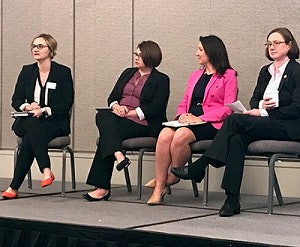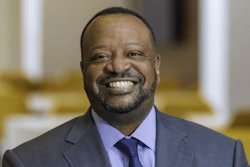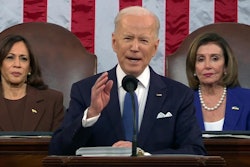WASHINGTON — The Education Commission of the States’ Higher Education Policy Forum brought together education stakeholders for conversations about how federal and state governments and education leaders can work together on higher-ed policy recommendations, including how to align K-12, post-secondary and workforce systems.
During panels Thursday, speakers discussed higher education policy efforts through the lens of access, affordability and accountability. Many highlighted the complexities of the education system that necessitate flexible and innovative models and practices to best support all students throughout their academic careers – while holding institutions accountable for outcomes.
 Panelists discuss affordability at the The Education Commission of the States’ Higher Education Policy Forum.
Panelists discuss affordability at the The Education Commission of the States’ Higher Education Policy Forum.“As one of the richest countries…we have the resources to improve access, affordability and completion,” said Rep. Bobby Scott, D-V.A., ranking member of the House Committee on Education and the Workforce. “But the federal government cannot do it alone.”
Scott encouraged leaders to forge federal-state partnerships to create or enhance innovative pathways such as dual-enrollment opportunities, programs that help students navigate remedial courses and initiatives that provide students and their families with information earlier to help them make smart college choices and financial-aid decisions.
The Congressional education and workforce committee is continuing its work on the PROSPER Act, a reauthorization of the 1965 Higher Education Act, Scott added. Some of the committee’s recommendations in the reauthorization are to increase maximum awards for Pell grants, reform loan-repayment programs to simplify them for all borrowers and assist colleges in accelerating students’ completion rates.
“We need your help to get there,” Scott said, encouraging educators, policymakers, families and others to reach out to their Congressional representatives.
In a panel on college access, speakers challenged education stakeholders and those who support students to think beyond the fundamental idea of access to college.
“It’s not just access, but access to what?” said Ben Miller, senior director for post-secondary education at the Center for American Progress. “We haven’t really talked about what you should be able to access.”
Broader conversations about access can combat the risk of students starting degree programs that may not deliver the promised opportunities.
 Liya Amelga
Liya AmelgaAlex Chough, vice president for government relations at the National Council for Community and Education Partnerships (NCCEP), said that some of the most successful college-access programs are those where institutional, state and local leaders sit down to set expectations for eliminating barriers for lower-income or minority students.
Beyond leadership setting the standard, Chough added, successful access programs have a commitment to research and evaluation of outcomes, to continual learning and to applying their data to practices that are constantly evolving. He cited the Chicago Educational Alliance and Gear Up as examples of initiatives that are working successfully to ensure that students succeed when they enter into their chosen educational institutions.
An investment in evaluative services will also allow institutions and other education leaders to identify which practices are working, Miller said. He suggested that the federal government can help guide expectations and push for institutions to “unlock” and research more data around student access programs and outcomes.
Providing earlier access to information about college, financial aid and career opportunities, especially for first-generation students and their families, also plays a role in the college-access conversation, panelists agreed.
They encouraged counselors, teachers and others to empower students to ask questions about colleges they are interested in. Specifically, some said, students should be asking, “What do outcomes look like for students like me?”
While students need this information, states also need a consistent definition on cost, credit hours and credentials in their higher education institutions so that students can fully understand what they are paying for, said Fran Bradford, Virginia’s deputy secretary of education, during the college affordability panel.
“What’s not affordable is not finishing,” Bradford said. “If we get folks into the system, we have to get them out.”
Julie Peller, executive director of Higher Learning Advocates, a nonprofit organization working to on federal policy that impacts higher education, sees “an opportunity” for conversations about what states need from the federal government as opposed to what the federal government wants states to do regarding issues of affordability.
“Completion is an affordability issue,” said Peller. “Success is an affordability issue.”
Approaching the 2019 gubernatorial election cycle, Joan Wodiska, senior federal affairs counsel at for the National Conference of State Legislatures, said her organization is developing a new national toolkit that will help state legislatures craft measures around best practices and models for college affordability.
Currently, states are looking at stackable credentials, competency-based education opportunities and ways to “blur and blend” the lines between the K-12 system, higher education and the workforce, she said.
“That’s how we as people experience education,” Wodiska said in reference to a future workforce that will require everyone to expand their skill sets for a range of career opportunities.
Liya Amelga, associate policy director for K-12 reform at Foundation for Excellence in Education, said accountability is about measuring the return on investment for higher education – and measuring the outcomes that were promised when the student first entered higher education.
The three broad groups invested in higher education — students and families, the business sector, and the government and taxpayers — have different expectations for their return on investment and outcomes for higher ed, Amelga noted.
Accountability metrics for student outcomes ought to be strengthened, but leaders should not let perfect get in the way of good, said Dr. Wil del Pilar, vice president of higher education policy and practice at The Education Trust.
Further, he said, leaders must think critically about accountability systems because institutions have different missions and serve different student populations. Using performance-based accountability systems, for example, may not be the best incentives for MSIs and community colleges, where students may not meet the outcome measures put in place by regulators.
In other cases, underrepresented students can be overlooked altogether in outcome measures, creating a challenge for institutions to identify and implement practices that support these students specifically, some speakers said.
Sarah Spreitzer, director of government relations at the American Council on Education, cautioned policy makers to be aware of “bad actors” that find ways “to game the system.”
Beyond Thursday’s gathering, educators and stakeholders can view their own organization and other educational entities as a resource to remain engaged for best practices in access, affordability and accountability, said leaders of the Education Commission of the States.
“Don’t let this be the end of the conversation for you,” said Dr. Christopher Mullin, director of Strong Start to Finish, an ECS initiative.
Tiffany Pennamon can be reached at [email protected]. You can follow her on Twitter @tiffanypennamon.


















